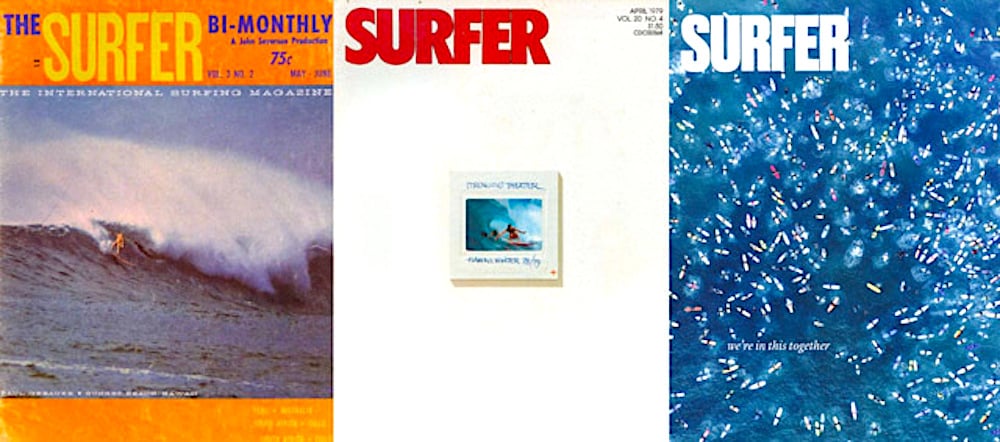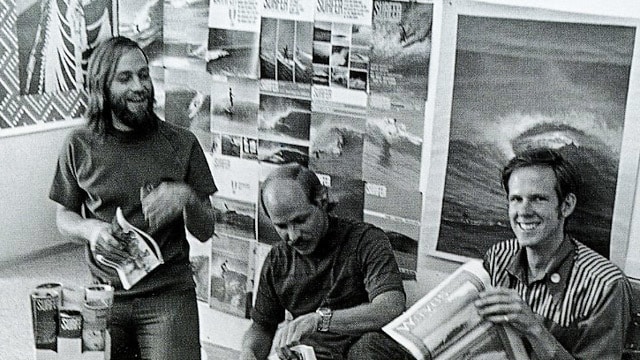“I left SURFER but SURFER never left me.”
In 1972, at age 12, I wanted to grow up and be Jeff Hakman or Jerry West, flip a coin.
Instead, I grew up to be the editor of SURFER, which is one of those consolation prizes that turns out to be better than the thing you wanted in the first place.
I was hired in 1985.
Creatively speaking, the magazine was in middling-poor shape when I arrived and middling-good shape six years later when I ceremoniously turned over my half-ton avocado-green Steelcase editor’s desk to Steve Hawk, who took SURFER from middling-good to very good indeed.
It was a great place to work: part surf club, part Warhol Factory, part The Office.
I liked the people I worked with. I liked the deadline pressure and having a worthy nemesis (thank you, Surfing), and as a subscriber and fan since 1969, I liked the weight of the place — having Severson, Stoner, Kampion, and Brewer looking over my shoulder (the first three metaphorically; Art Brewer actually looked over my shoulder and froze my blood on occasion with his famous hooded-eye stare).
In other words, I was both inspired and slightly awed at being part of the sport’s oldest and best magazine. I never set foot on the SURFER premises without intending to make the new issue better than the previous one — because it was my byline on the articles and my name at the top of the masthead, yes, but also because it was fucking SURFER, Bible of the Sport, and I still hate that tagline, but if you got the gig you honored and respected and were shaped by it nonetheless.

Stab reported on Friday evening that the entire SURFER staff had just been furloughed, and editor Todd Prodanovich soon confirmed on Instagram that the recent issue (above right) would be the magazine’s last.
SURFER had been hanging by a thread since it was sold to American Media (owner of National Enquirer) in early 2019, but the clock has been ticking since Al Gore invented the internet. Surf magazines will find a cozy little niche audience, like vinyl LPs, but with rare exception we’re 20 or so years removed from the day when a print article could break a story, set a tone, drive a discussion.
SURFER has long felt like a coda not just to its previous self, but to print media in general. Prodanovich said the “Covid economy” did SURFER in, but that’s not really true. The internet marched SURFER to the cliff — all the virus did was finger-push it over the edge. Digital is coming for us all, and yes I see the irony of this story appearing here.
(Encyclopedia of Surfing has dozens of SURFER-related pages. Click here to begin the deep dive.)
I’ve said that leaving SURFER at the end of 1990 was like shedding a skin. But thinking it over these past few days, I’m more aware than ever that SURFER in fact moved into me like a DNA transduction.
I left SURFER but SURFER never left me.
Art Brewer and Jeff Divine, for example, each with 50 years on the masthead, are my Polaris and Sirius of long-term high-quality work. Ron Stoner’s unschooled genius is my proof that savants live among us.
Thanks to the magazine’s incredible shape-shifting transformation in 1968, and again in 1991, I understand what “change or die” means.
Drew Kampion was the first SURFER writer I stole from, probably for a middle school essay, and I’ve done it ever since, right up to Sean Doherty’s recent Pipe Masters wrapup. John Witzig taught me how to come in with guns firing. Kevin Naughton and Craig Peterson taught me how to come in with a smile and a bro handshake and a case of beer.
Photographer Brad Barrett (below right) and art director Hy Moore (left), the quiet duo from SURFER’s 1968-1971 High Renaissance Age, and I do mean high, remind me that some of the finest and most valuable work goes uncredited.

I never met John Severson in person, but thanks to him I know that is possible to create something that is both specific and timeless, and that you can and should develop a full quiver of media skills. We are by and large an international collection of small-bore hustlers, back-paddlers, and bad-vibers, but at some deep plasmatic level we share a bond as surfers, and this was another received bit of Severson wisdom. “I wanted everybody to feel included,” he told me in 1995 when I asked why he originally called his magazine The Surfer. “It felt like we were something we were all going to do together.”
“We’re In This Together,” incredibly, is the lone cover blurb on SURFER’s final issue, and while I am warmed by this 1960-to-2020 symmetry and full-circleness, there is no getting around the fact that, with SURFER gone, we are suddenly and probably forever less together.
(Like Matt Warshaw’s flavour? This story comes from his weekly mail-out, sent to all good surfers who cut three bucks a month to subscribe to his bottomless archive of surf history. Join here.)





Recent Comments